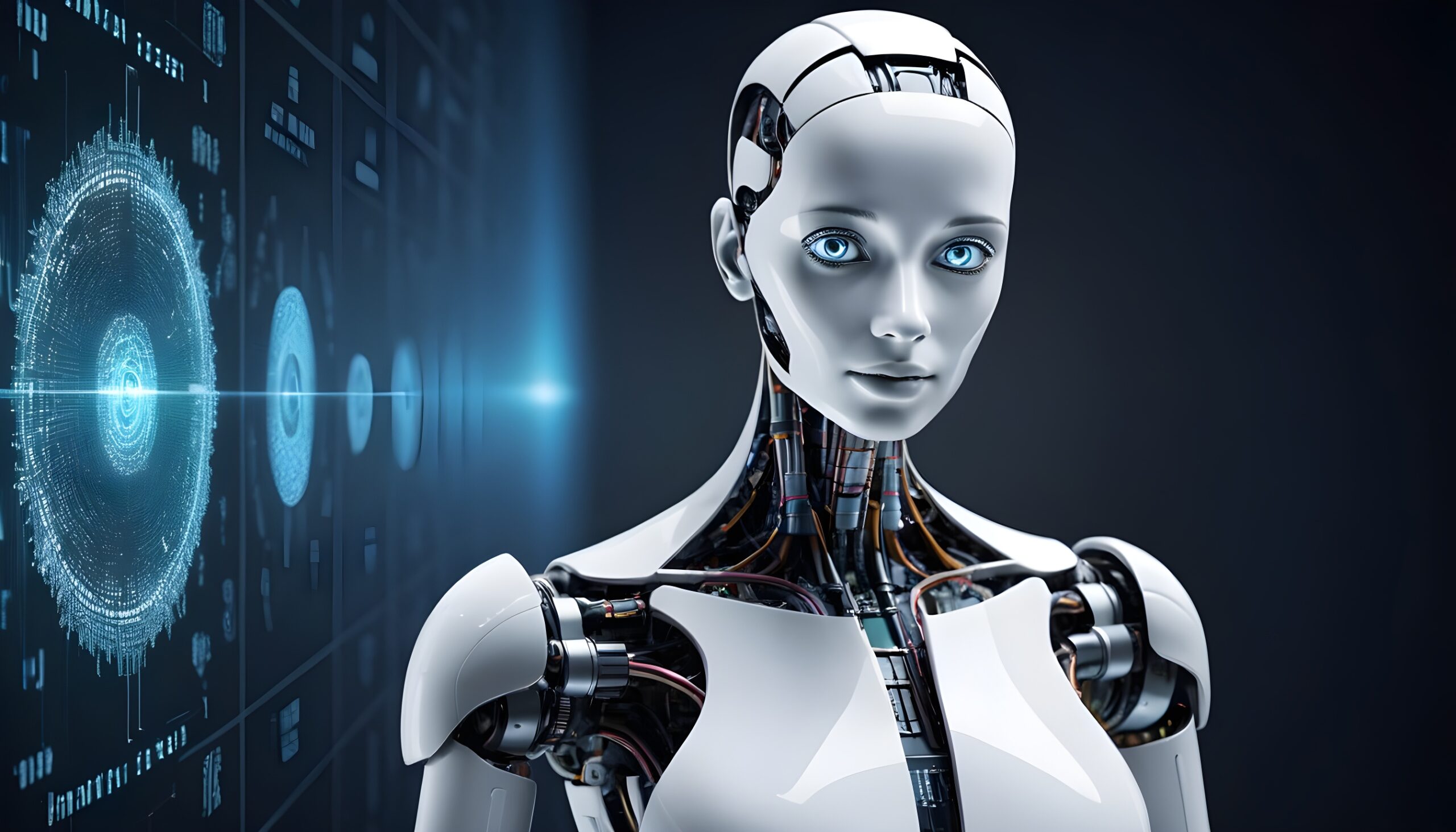Introduction
Welcome to the enchanting world of Artificial Intelligence (AI)! Often conjured up in the realms of science fiction, AI is no longer a mere fantasy of the future. It’s here, revolutionizing the way we live, work, and interact with the world around us. But what exactly is artificial intelligence? Simply put, it refers to the capability of a machine to imitate intelligent human behavior. From Siri and Alexa that make our lives more convenient to more complex systems that predict weather patterns or trade stocks, AI is embedded in many aspects of our daily lives. Whether you’re a curious mind, a student, or someone looking to dip their toes in the vast ocean of AI possibilities, this beginner’s guide is your first step towards understanding the basics of artificial intelligence, including machine learning, deep learning, and neural networks. Let’s embark on this exciting journey together, unraveling the mysteries of AI in simple, digestible terms.
What is Artificial Intelligence?
Definition of Artificial Intelligence
Artificial Intelligence (AI) might sound like something out of a sci-fi novel, but it has become a significant part of our everyday lives. At its core, AI is the simulation of human intelligence in machines that are programmed to think and learn like humans. The ultimate aim of AI is to create technology that can problem-solve, reason, plan, learn, and even understand natural language. It’s a broad field that encompasses many technologies, but the key idea is simple: machines making smart decisions.
Applications of AI in Everyday Life
You might be surprised to learn just how many facets of our daily routines are touched by AI. Here’s a quick rundown:
– Personal Assistants: Devices like Alexa and Siri use AI to follow your commands, from playing music to telling you the weather.
– Navigation and Travel: AI algorithms help map apps predict the fastest routes for your journey based on traffic, road closures, and even your personal preferences.
– Recommended Systems: Ever wondered how Netflix knows what shows you’ll binge-watch next? AI-driven recommendation engines analyze your preferences to suggest new titles.
– Healthcare: From diagnosing diseases faster to personalizing treatment plans, AI is revolutionizing the way we approach healthcare.
Understanding Machine Learning
Definition of Machine Learning
Machine Learning (ML) is a subset of artificial intelligence focused on building systems that learn from data. Instead of being explicitly programmed to perform a task, these systems are designed to analyze and interpret complex data, learn from it, and then make informed decisions based on what they’ve learned. In simpler terms, machine learning is about giving computers the ability to learn and adapt without direct human intervention.
Types of Machine Learning Algorithms
The world of machine learning is diverse, and its algorithms can be categorized into three primary types:
– Supervised Learning: This occurs when an algorithm learns from example input and output data, gradually improving its predictions. It’s like learning with a teacher to guide you.
– Unsupervised Learning: Here, the algorithm is let loose on a dataset without any explicit instructions on what to learn. It tries to find patterns and relationships on its own, much like learning through observation.
– Reinforcement Learning: This approach involves learning through trial and error, essentially rewarding the system when it makes a correct decision. Think of it as learning to ride a bike; you adjust your balance every time you lean too much to one side.
Real-World Examples of Machine Learning
Machine learning is not just a theoretical concept; it’s applied in countless ways across different industries. Here are a few examples:
– Fraud Detection: Financial institutions use ML to spot unusual patterns in transactions that may indicate fraud.
– Speech Recognition: Ever used Google Assistant to send a message? Behind the scenes, ML algorithms work to understand your speech.
– Self-driving Cars: These vehicles use ML to process the massive amounts of data from their sensors to make split-second decisions while on the road.
– Personalized Shopping: E-commerce websites use ML to analyze your browsing and purchase history to recommend products that you’re more likely to buy.
From understanding what AI and machine learning fundamentally are to seeing their applications in the world around us, it’s clear that these technologies are not just futuristic concepts but integral parts of our present reality. Whether it’s making our lives easier with personal assistants or revolutionizing industries like healthcare and finance, AI and machine learning are here to stay.
The Role of Neural Networks
Neural networks are at the heart of what makes artificial intelligence (AI) so powerful. Just as our human brain learns from experience, neural networks, a core part of AI systems, mimic the way human brains operate. Let’s delve deeper into what neural networks are and how they work.
What are Neural Networks?
Neural networks are essentially a series of algorithms designed to recognize patterns. They interpret sensory data through a kind of machine perception, labeling, or raw input processing. The patterns they recognize are numerical, contained in vectors, into which all of the real-world data, be it images, sound, text, or time series, must be translated.
Neural networks are structured like the human brain with thousands or even millions of simple processing nodes, called neurons, that are densely interconnected. Each neuron is responsible for performing a simple calculation on the input it receives. By working together, the network of neurons can process complex information and make decisions, recognize patterns, or perform tasks.
How Neural Networks Work
At its core, a neural network works in two steps: learning and inference. During the learning phase, the network is trained on massive amounts of data, adjusting and fine-tuning its connections (weights) between nodes based on the input data it receives and the output it’s supposed to generate. This phase is akin to a learning trial and error, where the network keeps adjusting until it can accurately predict an outcome based on the input.
In the inference phase, the trained network uses what it has learned to interpret new data, predict outcomes, or make decisions. For example, after being trained with thousands of images of cats and dogs, a neural network can begin to differentiate between images of cats and dogs on its own, even identifying them in images it has never seen before.
Neural Networks in Deep Learning
Deep learning is a subset of machine learning that uses deep neural networks — that is, neural networks with many layers. The “deep” in deep learning refers to the number of layers through which the data is transformed. More layers allow for the learning of more complex patterns in the data.
Deep neural networks have been responsible for many of the advancements in AI, including voice recognition systems, self-driving cars, and even defeating human champions in complex games like Go. The key to their success is their ability to automatically discover and learn from patterns in massive data sets, improving over time as they receive more data.
Impact of AI on Industries
AI’s rise is transforming industries across the board, reshaping the way we work, live, and interact with the world around us. Let’s explore how AI is making an impact.
– Healthcare: AI is revolutionizing healthcare by improving diagnostic accuracy, personalizing treatment plans, and even predicting patient outcomes. From analyzing medical images to identifying disease patterns, AI is making healthcare more efficient and effective.
– Finance: In the finance sector, AI is used for algorithmic trading, fraud detection, and personalized customer service. AI can analyze market data in real-time, make predictions about market trends, and automate routine tasks.
– Manufacturing: AI is streamlining manufacturing processes through predictive maintenance, quality control, and supply chain management. By predicting when machines are likely to fail or identifying defects in products, AI helps in reducing waste and improving efficiency.
– Retail: AI is transforming the retail industry by personalizing the shopping experience, optimizing inventory management, and automating customer service interactions. From recommendation engines to chatbots, AI is enhancing the customer journey in retail.
In each of these industries, AI is not just a tool for automation; it’s driving innovation, improving accuracy, and enhancing decision-making. As AI technology continues to evolve, its impact on industries is set to deepen, promising even more profound changes in the years ahead.
The Future of Artificial Intelligence
The future of artificial intelligence (AI) is not just a topic of scientific research but a window into a world where technology can potentially transform every aspect of our daily lives. From the way we work and learn to how we interact with each other, AI holds the promise to revolutionize the fabric of human experience. With advancements cropping up at an unprecedented pace, it’s both thrilling and essential to stay informed about where AI could take us next.
Advancements in AI Technology
The field of AI is on the brink of several groundbreaking advancements. For starters, machine learning algorithms are getting smarter and more efficient, allowing computers to learn from data in a way that mimics human learning but at a much larger scale. This means AI can improve over time without human intervention, potentially leading to breakthroughs in diagnosing diseases, predicting weather patterns, and understanding human behavior.
Deep learning, a subset of machine learning, is making it possible for AI to recognize images, understand spoken words, and generate human-like text. This opens up possibilities for AI in creative fields like music, art, and literature. Furthermore, the development of neural networks, complex algorithms modeled after the human brain, is paving the way for AI systems that can think, learn, and reason more like humans.
Ethical Considerations in AI Development
With great power comes great responsibility. The advancement of AI technology raises important ethical considerations that must be addressed to ensure that the development and application of AI benefit society as a whole. Privacy issues, fairness, accountability, and transparency are at the forefront of these considerations.
There’s the question of how AI decisions impact individual rights and freedoms, emphasizing the need for AI systems that respect privacy and are designed to be fair and unbiased. Moreover, accountability in AI decisions is crucial; humans should remain in the loop, especially in critical areas like healthcare and law enforcement, to oversee AI actions and intervene when necessary. Lastly, transparency in AI systems is vital for building trust and understanding among users, ensuring that people know how AI decisions are made and based on what data.
In conclusion, as we look toward the future, the potential of AI is vast and full of promise. By advancing our understanding and application of AI technology while carefully navigating its ethical considerations, we can harness this potential to create a brighter, more efficient, and more equitable world for generations to come.
Conclusion
And there you have it, folks – a beginner’s guide to the sprawling, exciting world of artificial intelligence. By now, you likely have a clearer picture of what AI is, including its subfields like machine learning, deep learning, and neural networks. While AI might seem complex at first, understanding its basics is the first step towards demystifying this technological marvel.
– Remember: AI is not just about robots taking over the world. It’s more about creating systems that can learn and make decisions, potentially making our lives easier.
– Explore: Don’t stop here! The world of AI is continuously evolving. There are endless resources online to deepen your understanding.
– Engage: Get involved in conversations about AI. Whether it’s online forums, social media, or local meetups, sharing ideas can enhance your learning.
In wrapping up, we encourage you to stay curious. Don’t be afraid to dive deeper into the topics that intrigue you the most. Whether it’s machine learning algorithms, the architecture of neural networks, or the ethical implications of AI, there’s a whole universe waiting to be explored. Here’s to your journey in AI – may it be enlightening, empowering, and exciting!





















